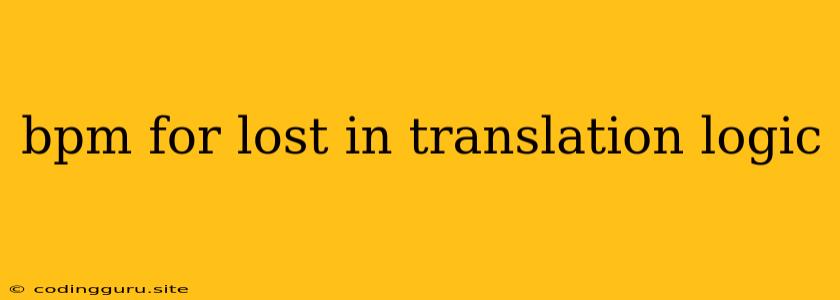BPM for Lost in Translation Logic: Bridging the Gap
In the bustling world of software development, where communication is key, a common challenge arises: Lost in translation logic. This perplexing phenomenon occurs when the intended functionality of a software system is not accurately conveyed between stakeholders, leading to misinterpretations and ultimately, flawed software. To combat this, Business Process Management (BPM) emerges as a powerful solution, offering a structured framework for capturing and communicating complex logic.
What is Lost in Translation Logic?
Lost in translation logic manifests itself in various forms. Consider these scenarios:
- A developer misunderstands a requirement. The business analyst might have outlined a process flow, but the developer misinterpreted the intended sequence of events.
- The design document lacks clarity. A poorly structured design document, devoid of detailed descriptions and visualizations, can leave room for ambiguity.
- Miscommunication between teams. Imagine a scenario where the development team fails to properly communicate their progress to the testing team, leading to delays and rework.
These are just a few examples, but the underlying problem remains the same: a disconnect between the intended functionality and its actual implementation.
How Can BPM Help?
BPM, with its emphasis on process modeling, visualization, and documentation, provides a robust solution to address lost in translation logic. Let's delve into the specific ways BPM can contribute:
1. Clear Process Definition: BPM allows stakeholders to collaboratively define and document business processes through process modeling. By using standard notations like BPMN (Business Process Model and Notation), the process flow is visually represented, eliminating ambiguity and ensuring everyone is on the same page.
2. Improved Communication: BPM facilitates open communication by providing a centralized platform for process documentation and discussion. Teams can collaborate on process models, share feedback, and ensure all aspects are understood and agreed upon.
3. Enhanced Visibility: BPM offers complete visibility into the entire process flow. Stakeholders, from business analysts to developers and testers, can easily access and comprehend the process model, enabling them to understand the expected behavior of the system.
4. Automated Validation: BPM tools offer automation capabilities, allowing for process simulation and testing. By simulating the process flow, potential bottlenecks, errors, and inconsistencies can be identified and addressed proactively, preventing lost in translation logic.
Implementing BPM for Lost in Translation Logic
Here's how you can leverage BPM to tackle lost in translation logic:
1. Define the Business Process: Work with stakeholders to meticulously define the business process, capturing all essential steps and interactions.
2. Model the Process: Use BPM software to create a visual representation of the process flow, leveraging BPMN or similar notation. Include clear descriptions and annotations for each step.
3. Document the Logic: Incorporate clear, detailed documentation for each process step. Outline the logic behind each decision point, input and output parameters, and any relevant business rules.
4. Share and Collaborate: Share the process model and documentation with all stakeholders. Encourage feedback and ensure everyone understands the process flow and its associated logic.
5. Validate and Test: Use the BPM software's simulation capabilities to test the process flow and identify any inconsistencies or potential errors.
Conclusion
Lost in translation logic poses a significant challenge in software development, leading to delays, rework, and ultimately, software that fails to meet expectations. By embracing BPM, organizations can establish a structured framework for defining, documenting, and communicating complex business logic, effectively bridging the gap between stakeholders and ensuring that software implementations align with intended functionalities.
